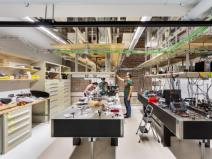Ni Lab Renovation - FAS
Ni Lab Renovation - FAS
Project highlights
- 35% reduction in water use below code maximum
- 100% of the eligible equipment and appliances by rated power are ENERGY STAR certified
- 100% of individual and shared multi-occupant spaces have daylight responsive lighting controls
- 32% reduction in lighting power density
- 100% of the project’s adhesives, sealants, paints, coatings, and flooring systems are low-emitting
Project summary
Laboratories are typically regarded as an energy intensive building typology. Many of these buildings have extended occupancy periods, energy intensive equipment and machinery, and in some cases, strict air quality code requirements (high air changes per hour). These factors contribute to a high average energy use intensity value (National Average EUI of 370 kBtu/SF/year). Additionally, some laboratories consume significant amounts of water through process and HVAC equipment use. Nevertheless, there are many strategies that can be employed to make laboratories more energy and water efficient as well as healthy and productive spaces with minimal environmental impact. The Ni Lab is a great example of the successful implementation of these strategies.
The Ni Lab project consisted of the renovation of the existing Library and support spaces located on the first floor of the Converse Building Extension at Harvard University. The scope of work included a partial renovation of the existing Library for two new laser laboratories and associated support spaces including a preparatory room, a conference room, clean and dirty shop spaces, and offices. The project’s goals were to create high performance lab spaces that optimize the indoor environment, reduce resource consumption, and reduce the overall impact on the environment.
The project team was committed to sustainability from the onset and followed the Harvard Green Building Standards to make more informed decisions. These standards led to the inclusion of a number of progressive design strategies to meet aggressive energy targets and reduce water use without significant additional cost. The project achieved LEED-CI v3 Gold certification in March 2016.


